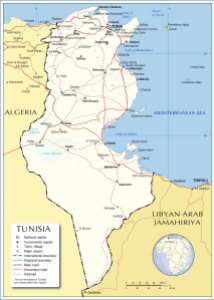For general information about the country profiles click here.
 Population: 10,777,500
Population: 10,777,500
HDI Rank: 94/187
HDI Score: 0.712
In spite of political gridlock and bouts of instability after the Jasmine Revolution overthrew the oppressive rule of President Ben Ali in 2011, Tunisia has made some initial steps towards democracy and decentralization. The signing of Tunisia’s new constitution in the beginning of 2014 hopefully points to the end of repressive and corrupt centralized power, and sets a course to establish and strengthen effective and autonomous local democratic institutions in the future. But Tunisia must confront pressing social issues and slow recovering economy in addition to bringing the mandates of the constitution into fruition.
Local governance at a glance
- Tunisia is divided into 24 provinces (governorates or wilaya: mix of deconcentrated administrative structure and a local authority), then subdivided into delegations (mutamadiyat) or districts (shaykhats) and sectors (imadats) (UCLG, 2006).
- Each province is headed by a governor who is appointed by the president through the secretary of interior (Encyclopedia of the Nations, 2014).
- There are 264 municipalities which are governed by 165 rural councils (UCLG, 2006).
- New municipalities were created by decree, upon proposal from the Ministry of the Interior and following consultation with the Ministries of Finance and Equipment. Thus, municipalities’ activities are controlled under trusteeship (UCLG, 2006).
- Tunisia does not have legislated gender quota at the local level (Quota Project, 2014).
Civil society actors include
- Association Tunisienne des Femmes Democrates works on women’s rights in a democratic framework. Main working areas include the participation of women in civil and political life.
- Al Bawsala’s one of objectives is to reposition citizens at the core of political action by making them stay updated with elected representatives and providing them ways to defend their fundamental rights.
- Association Tounissiet aims to promote the role of women and strengthen capacity of women on the full involvement in a modern society with an active role in decision-making positions.
Capacity building institutions
- Agence Urbaine du Grand Tunis (Greater Tunis Urban Agency) is the only example of intermunicipal organizations. Its’ objective is to deliver studies related to urban planning and to assist public local authorities (CMI, 2010).
Fiscal control
- Local authorities do not have any autonomous fiscal control, and the taxation process and the fiscal tool are out of the hands of local authorities (UCLG, 2006).
- There is a financial aid from the State. Half of this is transferred from the common fund for local authorities in the form of an operations allowance. The other half comes from the loan and support fund for local authorities, which has the monopoly to local authorities (UCLG, 2006).
Key initiatives for participatory local governance
- The Law No. 75-33 of 14 May 1975 granted municipalities certain number of responsibilities and power including social, economic, cultural development in surrounding areas (UCLG, 2006).
- On January 14, 2011, youth-led protests were fueled by socioeconomic grievance and political repression, and long-time President Zine el-Abidine Ben Ali fled the country. The revolution prompted the initial steps towards democracy and political reform (USAID, 2013).
- Freedom of the press was established after the revolution, resulting in dozens of radio stations and newspapers contributing a variety of opinions throughout the country (DW, 2014).
- On January 26, 2014, a new constitution was adopted. The Capter VII recognized that decentralization process is the essential starting point for more efficient and accessible administration to the citizens, and also mandates free and transparent elections for local governments (UCLG, 2014).
- The new constitution 2014 also mandates that local governments will have their own legal personality in addition to administrative and financial competence and autonomy (UCLG, 2014).
Challenges for participatory local governance
- There are a lack of knowledge and information on general democratic principles and lack clear process for marginalized groups such as youth and women to be engaged and influence political processes (USAID, 2013).
- Civil society’s lack of capacity limits its effectiveness and influence (USAID, 2013).
- Local authorities have the lack of financial power of local assemblies and the low level of local resources. Their financial vulnerability and lack of human resource explain the fact that the majority of responsibilities assigned to municipalities have remained fairly ineffective and their service are not sufficient (UCLG, 2006).
Recent posts on this website about Tunisia :
______________________
List of sources (in order of citation):
UCLG, 2006: “Tunisia”
Encyclopedia of the Nations, 2014: “Tunisia – Local Government”
Quota Project, 2014: “Tunisia”
Center for Mediterranean Integration (CMI), 2010: “Agence Urbaine du Grand Tunis (AUGT)”
USAID, 2013: “Tunisia Transition Initiative (TTI)”
Deutsche Welle (DW), 2014: “Tunisia three years after the revolution”, Ute Schaeffer
UCLG, 2014: “Local government in Tunisia’s new Constitution”
